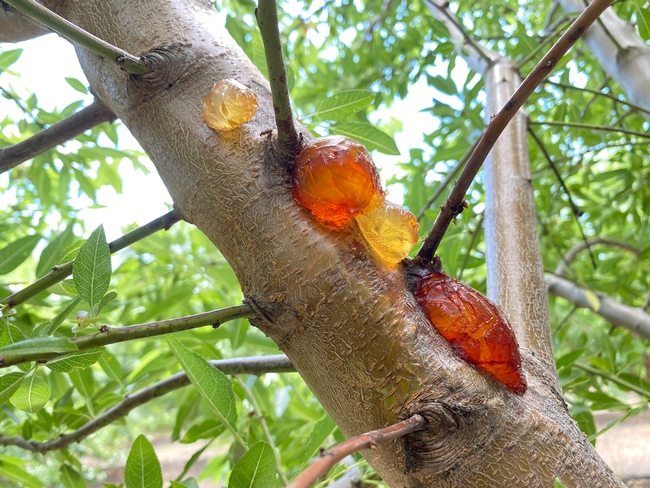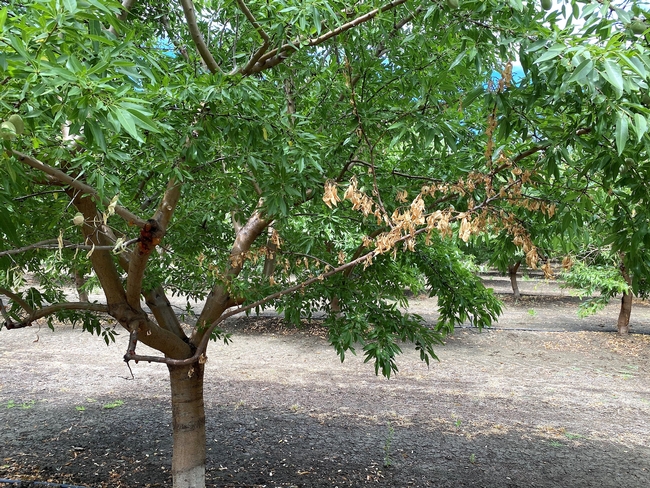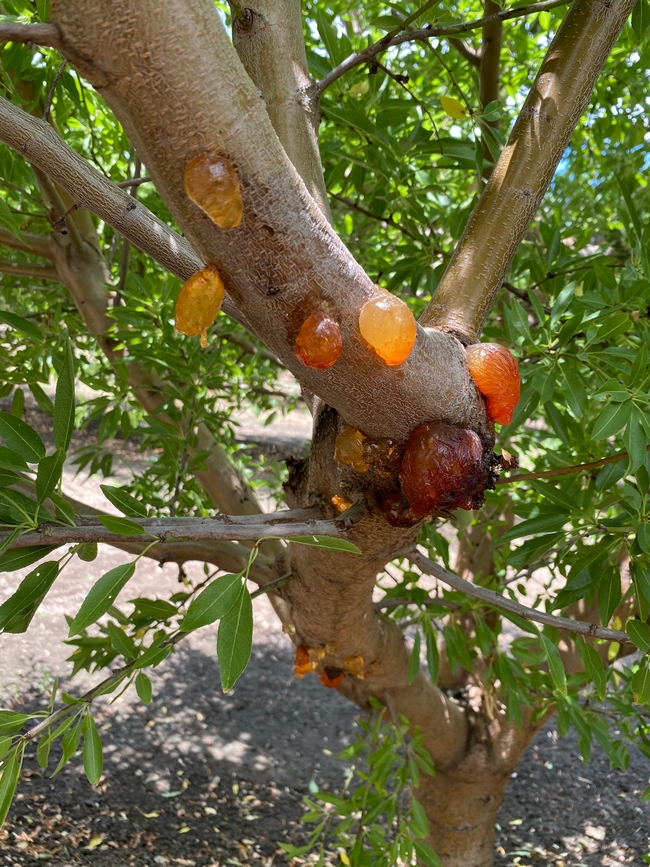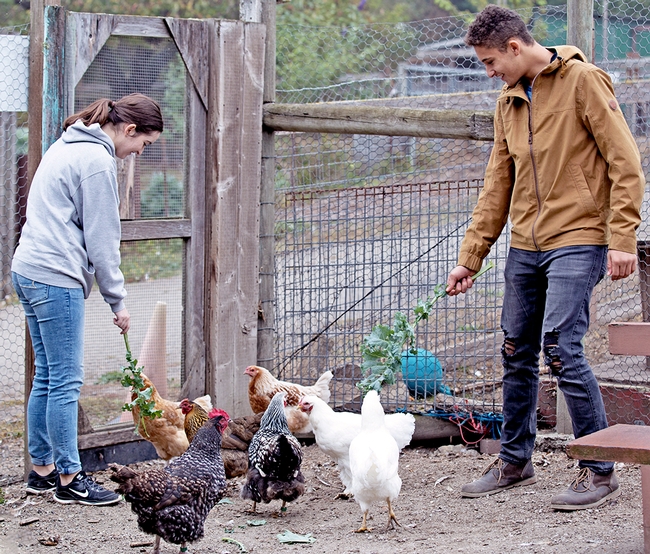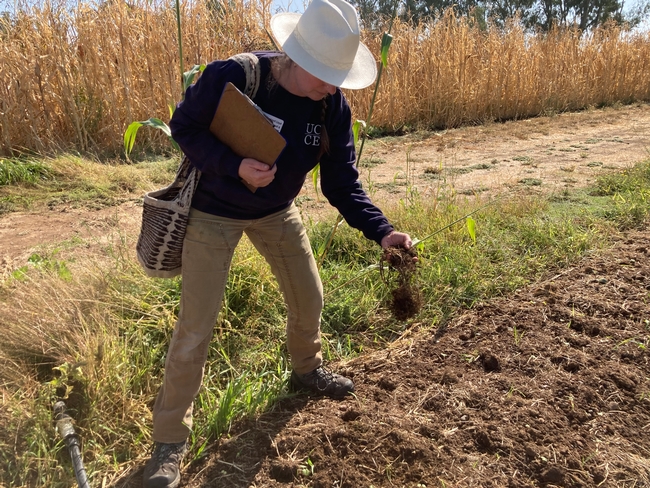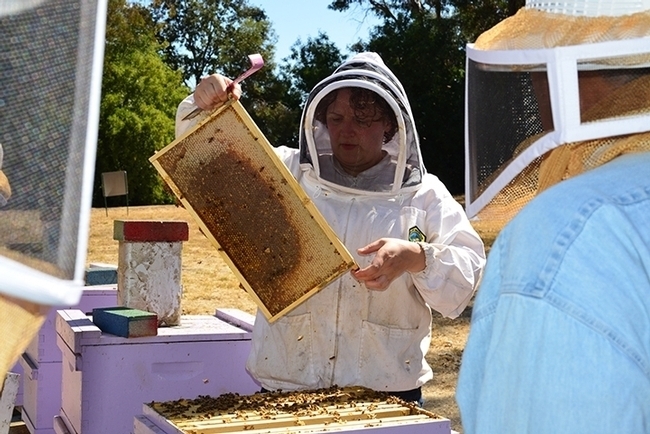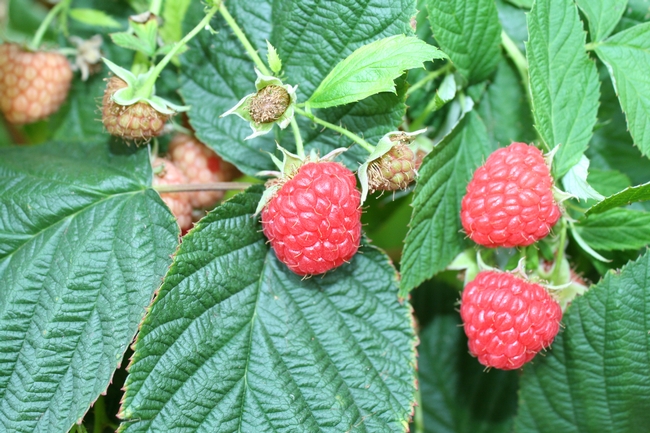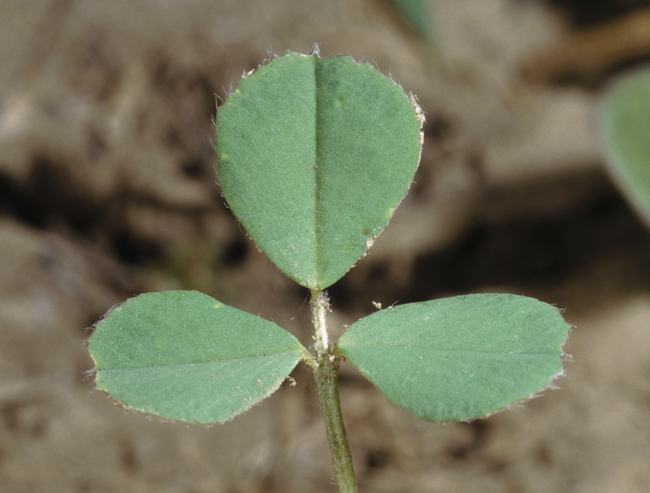UC Food Blog
Almond growers should prepare for possibility of unusual disease outbreak
Wet winter, El Niño create favorable conditions for aerial Phytophthora pathogen
With heavy rains in the forecast amid strengthening El Niño conditions, almond growers should be on the lookout for a rare disease that can cause severe damage to their orchards, according to Florent Trouillas, a University of California Cooperative Extension specialist in fruit and nut pathology.
Phytophthora, soilborne microorganisms dubbed “water molds” because of their dependence on water, typically cause root and crown rot at the base of trees. But a few aerial Phytophthora can travel upwards and infect the higher parts of the tree. One species – Phytophthora syringae – is drawing special attention due to an unprecedented outbreak last winter, fueled by the atmospheric rivers that lashed California.
“It was found statewide – meaning in every almond-producing county – and disease incidence in orchards ranged from 10% of the trees infected to 75%,” said Trouillas, a UC Davis plant pathologist whose lab is based at UC Agriculture and Natural Resources' Kearney Agricultural Research and Extension Center in Parlier.
Trouillas and his colleagues, UC Davis graduate student Alejandro Hernandez and UC Riverside plant pathology professor Jim Adaskaveg, recently published a detailed online article describing the pathogen, which can infect a range of crops but mainly impacts almonds in California.
Although it doesn't kill the tree, the disease causes branch dieback that requires significant additional work and expense for almond growers. In 2022, almonds were the state's fourth-highest valued commodity, at $3.52 billion.
During last year's aerial Phytophthora outbreak, researchers also observed a new and troubling phenomenon: P. syringae, historically known to attack the cuts caused by pruning, was directly infecting the young shoots on almond trees – without any wounds.
“This was really the first time we had seen widespread evidence of infection on the twigs,” Trouillas said.
Although generally rare, outbreaks of P. syringae have been traditionally associated with wet El Niño years, according to Trouillas – and recent and persistent rain across the state should have growers on high alert.
Prune in dry weather, monitor, mitigate if necessary
While almond growers tend to prune during the downtime of winter, they should keep an eye on the forecast and aim for a 10- to 14-day window of dry weather to perform those tasks, whether training young trees or maintaining the established ones.
“If growers were to prune around a rain event – before, during or shortly after – this increases the likelihood of infection because this pathogen moves around with water,” Trouillas explained.
Researchers speculate that P. syringae, normally found in the soil, gets carried into the upper parts of a tree through strong winds and heavy rain. Alternatively, harvest processes like shaking and sweeping also produce air movements that may blow the microorganism into the canopy, where it waits for a favorable wet environment. The pathogen then attacks the wounds or young shoots, producing characteristic cankers and gumming.
The patterns and colors of the gum balls are keys to diagnosing an infection of this particular aerial Phytophthora. Starting around bloom time (mid-February), growers should monitor pruning wounds and young shoots on their trees, especially in the canopy, for signs of the disease.
The unique coloration of the gum balls – ranging from gold and amber to dark burgundy to bright red (see photos) – generally indicates P. syringae infection. But growers are urged to contact their local Cooperative Extension advisor for confirmation.
“It is super critical for growers that, whenever they see gumming, not to assume that it is this aerial phytophthora, because there are many other diseases that can cause gumming on the tree,” Trouillas said.
If the diagnosis is confirmed, growers may apply a compound that can mitigate the infection. The plant pathologists' recent writeup describes several curative treatment options, as well as a preventive measure that reduces the amount of pathogen in the soil and thus the likelihood of infection.
For more information on the pathogen's history and biology, as well as various options for disease management, visit the article on Sacramento Valley Orchard Source: https://www.sacvalleyorchards.com/almonds/trunk-soil-diseases/aerial-phytophthora-outbreaks-in-wet-years.
Bird owners urged to take precautions for avian flu
The highly contagious avian flu is being spread primarily by migratory birds, putting game birds, and backyard and commercial poultry at risk.
“Poultry owners should take precautions to prevent their birds from contacting waterfowl or the habitat that waterfowl frequent because this strain of avian influenza is highly contagious,” said Maurice Pitesky, UC Davis School of Veterinary Medicine associate professor of Cooperative Extension.
Infected waterfowl shed the highly pathogenic avian influenza virus in their feces and respiratory secretions, where the virus can remain viable for months in the environment.
“If you can't confine your birds in a coop, focus on good sanitation and reducing contact with waterfowl and their habitat such as agricultural fields and ponds,” he said.
Pitesky urges commercial and backyard chicken owners to monitor their birds for the following symptoms:
- Reduced egg production
- Trouble breathing
- Clear, runny discharge from nose, mouth and eyes
- Lethargy or lack of energy
- Loss of appetite
- Drinking less
- Swollen eyes, head, wattles or combs
- Discolored or bruised comb, wattles or legs
- Sudden death
To prevent exposure to potentially infected waterfowl, Pitesky suggests reassessing and redoubling biosecurity efforts to prevent contact between wild animals and domestic poultry.
Specifically, he recommends keeping birds away from ponds and other open water where they may contact waterfowl, which are the primary reservoir of the disease. To prevent cross-contamination, use clothing and boots that stay on your property and avoid sharing equipment with other bird owners.
A local veterinarian or UC Cooperative Extension farm advisor may have more suggestions to reduce risk.
For more information about protecting birds from avian influenza, visit https://ucanr.edu/sites/poultry/files/225352.pdf.
Unusual or suspicious sick or dead domestic birds should be reported to the California Department of Food and Agriculture Sick Bird Hotline at (866) 922-2473.
Suspicious wild bird deaths can be reported to California Department of Fish and Wildlife (CDFW) at https://wildlife.ca.gov/Conservation/Laboratories/Wildlife-Health/Monitoring/Mortality-Report.
UC offers resources for urban farmers at EcoFarm
University of California scientists will be participating in the 44th Annual EcoFarm Conference Jan. 17-20 in Pacific Grove. EcoFarm participants gather to celebrate and learn about advances in farming and food systems throughout the state. This year, the three-day conference will highlight Black, Indigenous and People of Color communities that depend on agriculture, while also showcasing the new technological advances that further the development of agriculture.
Researchers from the UC Davis Veterinary Teaching Hospital's Department of Population Health, the Western Institute of Food Safety and Security and UC Agriculture and Natural Resources will be attending the conference to highlight the importance of food safety and technical skills in urban farming.
At EcoFarm, the Western Institute of Food Safety and Security will showcase its Civic Urban Farmer Program with an exhibit. The program, led by UC Davis assistant project scientist Sara Garcia and supported by UC Cooperative Extension, strives to uplift BIPOC communities.
The Civic Urban Farmer Program
The Civic Urban Farmer Program – a no-cost, 11-week program for farmers in the Sacramento region and Bay Area – provides technical support for new and upcoming urban farmers through webinars and in-person events. The program is available for any race, gender, age and skill ability, and seeks to provide safe, expert advice for farmers at any scale.
Soil health, composting, pest management, business marketing, food safety and urban policy are among the topics covered in its lecture-style classes.
Earlier this year, the program graduated its second cohort, with the support of two nonprofit organizations, Three Sisters Gardens in West Sacramento and Common Vision in Oakland. The program is supported by industry professionals, researchers and government officials, as well as local nonprofit and non-governmental organizations.
Elina Niño, UC Cooperative Extension specialist in apiculture, joined the Civic Urban Farmer Program to support urban farmers with training on managing pollinators to increase crop yields and create value-added products such as honey. The success of the pollinator program revealed that small urban farmers desire resources and education that are tailored specifically toward the cultivation of healthy and safe food.
For more information about the Civic Urban Farmer Program, visit https://www.wifss.ucdavis.edu/urbanfarmers.
Organic Agriculture Institute
The UC Organic Agriculture Institute, led by UC Cooperative Extension specialist Houston Wilson, will have an exhibit at EcoFarm. UC Organic Agriculture Institute brings together growers, certifiers, consultants, community groups and other stakeholders with UC research and extension personnel to share information about organic farming.
For more information about the UC Organic Agriculture Institute, visit https://organic.ucanr.edu.
Workshop speakers
Several UC Cooperative Extension advisors will be speaking at EcoFarm, including Richard Smith, UCCE emeritus vegetable crops advisor; Patricia Lazicki, UCCE vegetable crops advisor; and Margaret Lloyd, UCCE small farms advisor.
Connect with @ucanr on X, Instagram and LinkedIn.
New UC study estimates raspberry production costs on Central Coast
A new study that estimates costs and potential returns for growing raspberries on the Central Coast is available for free from UC Agriculture and Natural Resources, UC Cooperative Extension and the UC Davis Department of Agricultural and Resource Economics.
“These studies provide growers with a baseline to estimate their own costs, which can help when applying for production loans, projecting labor costs, securing market arrangements, or understanding costs associated with water and nutrient management and regulatory programs,” said Brittney Goodrich, UC Cooperative Extension specialist and study co-author.
The UC Cooperative Extension study focuses on raspberries grown in Santa Cruz, Monterey and San Benito counties for the fresh market.
The cost study models a management scenario for a 45-acre farm, 42 acres of which are planted to raspberries. The remaining acres are for the irrigation system, roads and buildings. Each study describes the cultural practices used for establishing, producing and harvesting raspberries, including land preparation, soil fertility and pest management, irrigation and labor needs.
The 36-page study shows costs for each operation, material inputs and costs, and cash and non-cash overhead costs in a variety of formats for three production years. A ranging analysis for each production year is also included and shows potential profits or losses over a range of prices and yields. The authors also note California's 2023 minimum wage and overtime rules.
The new study, “2023 Sample Costs to Produce and Harvest Raspberries,” can be downloaded from the UC Davis Department of Agricultural and Resource Economics website at https://coststudies.ucdavis.edu.
For a detailed explanation of the assumptions and calculations used to estimate the costs and potential returns for each crop, readers can refer to the narrative portion of the study.
For more information, contact Mark Bolda, University of California Cooperative Extension farm advisor, at mpbolda@ucanr.edu, Laura Tourte, emeritus UC Cooperative Extension farm advisor, at ljtourte@ucanr.edu, or Jeremy Murdock in the Department of Agricultural and Resource Economics at jmmurdock@ucdavis.edu.
Sample cost of production studies for many other commodities grown in California are also available for free at https://coststudies.ucdavis.edu.
California Plant and Soil Conference set for Feb. 6-7 in Fresno
The 2024 California Plant and Soil Conference will be held Feb. 6-7 at the DoubleTree Hotel in Fresno. The conference is organized by the California Chapter of the American Society of Agronomy and UC Cooperative Extension.
This year's conference will cover the following topics:
- Are we ready? Adapting agronomy to an uncertain future
- Precision agriculture
- Nutrient management
- Micronutrients
- Animal-plant systems management
- Soil management
- California IPM toolbox
- Pesticide resistance
- Bees, pollinators
- Groundwater recharge
- On-farm water management
“The diverse topics covered at the annual California Plant and Soil Conference are determined by polling members each year about what information is most important for them to learn about regarding sustainable agricultural production in California,” said Nicholas Clark, conference organizer and UC Cooperative Extension farm advisor, who specializes in agronomy and nutrient management.
Growers, pest control advisers and crop consultants, allied ag industry professionals, academics, and government agency staff attend this accessible, science-based conference each year to stay up-to-date on major issues in California agriculture and their potential solutions. In addition to networking opportunities, the conference offers continuing education credits for growers and other ag professionals seeking to maintain various licenses.
“Another really cool thing about this conference is that the chapter has a strong career development component to it,” said Clark. “We support students through financial assistance to attend as poster presenters, and we give monetary awards to student poster contest winners judged by members of the CA ASA board and industry professionals. We also have a merit-based scholarship award given to students each year for their contributions to and potential in the agricultural industry and science fields. These awards are largely supported by private sponsors and member dues.”
The annual conference provides an opportunity for all attendees to increase their knowledge of current topics of agronomic importance in California. By attending the conference, certified crop advisers and pest control advisers can earn continuing education units that are important to their professional standing.
The agenda for the conference includes several new items this year:
- Two additional sessions with six speakers will be offered on the afternoon of Feb. 7 after the business lunch.
- A student-mentor breakfast meeting will be held the morning of Feb. 7 with round-table discussions to hear about mentors' experiences and career paths in agricultural science fields, providing a chance to network and broaden perspectives.
In addition to presentations, there will be an award ceremony to honor individuals who served the profession through their careers, a student poster competition, non-competitive professional posters, and the CA ASA business meeting. Sponsorship opportunities are available to support student participation. For more information, please see the conference website at https://na.eventscloud.com/website/58588/sponsors.
Registration is $375. Early bird registration is $325 and ends Jan. 12. Registration on site will be $425. Register through the conference website: https://na.eventscloud.com/plantandsoilconference.
The conference is planned and presented by a team of volunteer professional agronomists from research institutions, UC Cooperative Extension, public agencies and private companies. If you are interested in serving on the board or have questions about the conference, please contact a current board member (https://na.eventscloud.com/website/58588/leadership).
The California Chapter of the American Society of Agronomy was founded in April 1971 by a group of California agronomists who recognized the value in creating a forum to focus on California agriculture. The purpose of the annual meeting is to promote research, disseminate scientific information, foster high standards of educational and ethical conduct in the profession, and facilitate robust cooperation among organizations with similar missions.


